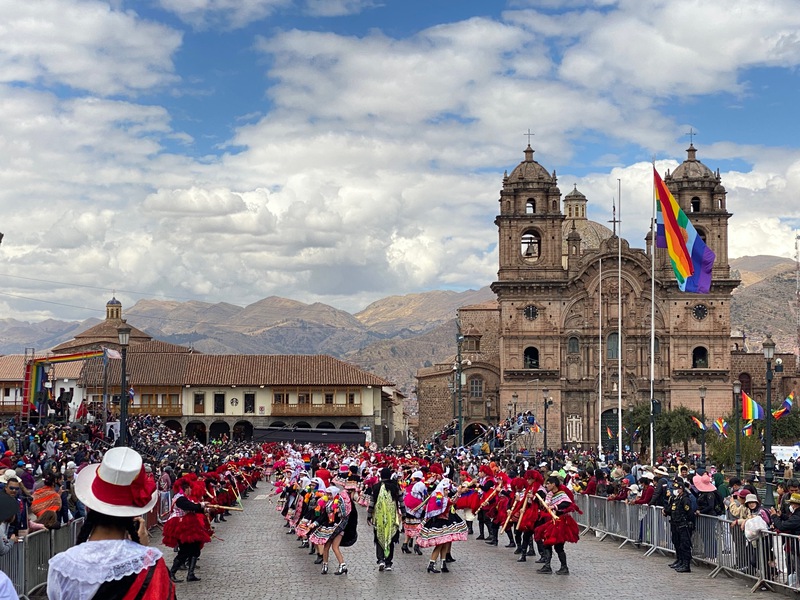We returned to the same hotel we'd stayed in before, took hot showers, and ordered a pizza via WhatsApp.
The next morning, we walked to Plaza de Armas to visit the Cathedral, and found another parade going on.
We couldn't take pictures inside the cathedral, but walked around many side chapels and altars covered
in elaborate gold and silver decorations.
After lunch, we walked up a street that turned into stairs
to San Cristobal, for a great view of the city below. In the afternoon, we went to a chocolate workshop,
where we learned about how cacao beans become chocolate. We roasted and shelled cacao beans, then
ground them into a paste with a mortar and pestle. Our instructor helped us make three hot drinks:
tea from cacaco shells and honey, original hot chocolate with water, cacao paste, honey, and chile, and the European version with milk, cacao paste, honey, cloves, and cinammon. Finally, we chose molds and
created our own chocolates with mixins such as coca powder, Maras salt, sprinkles, and dried fruits.
The rafting company offered us a city tour of Cusco since our rafting trip was cut short. Our guide
and driver picked us up at our hotel, and drove us up above Cusco to the nearby Inca ruins. We
started at Tambomachy, then made our way back to Cusco with stops at Puka Pukara, Q'enco, and
Saqsaywaman. At each stop, our guide explained what the sites may have been used for by the Incas.
Back in town, the driver dropped us off at the Convent of Santo Domingo, built on the site of the
Inca temple of Coricancha. We walked through a mix of architectures: a Spanish monastery with hallways of religious paintings, alongside Inca buildings with perfectly fit giant stone blocks.
We'd reserved an Airbnb near the airport for the afternoon; our original plan was to get back Cusco
around 4pm, and we wanted to be able to shower and re-pack before our 8pm flight. The loft was small
but a bargain ($29); we showered, walked to lunch, charged our devices, napped, then met the taxi
called by our host to start our trip home.


We walked to the Plaza de Armas to see the Cathedral, and saw another parade.
Groups in elaborate costumes paraded past stands full of people in the Plaza de Armas.

The Cathedral is filled with elaborate altars but doesn't allow photography.

This version of the Last Supper by a Cusco artist features a guinea pig as the main course.

After lunch, we walked up the stairs toward San Cristobal.


Two alpacas were available for petting and pictures with tourists in the church courtyard.



We climbed steep steps in the bell tower of San Cristobal.

view of the Plaza de Armas from San Cristobal



This baby looked like it was just learning to walk.

walking back down from San Cristobal

the parade was still going when we got back down to the Plaza

Several groups walked around this dog in the street.


We went to a chocolate workshop at the Cusco Choco Museo.

Our instructor described the steps in making chocolate.

The cacao pods go directly from the tree.

The cacao beans grow in big pods on a tree.
Evan used a mortar and pestle to grid roasted cacao beans into a paste.

After roasting and grinding cacao beans, our instructor added milk and honey, and we mixed it with a wooden tool.

We chose molds, then spooned melted chocolate and mixins into them.


We went back to pick up our chocolates after dinner.
The parade was still going in the Plaza de Armas after dinner.

Our guide said Tambomachay may have been an elite guest house.

The aqueducts channel water for agriculture.

Our guide said the walls are arranged so that the sun hits the water and blesses it.



Puka Pukara was probably a fortress protecting Cusco.

This chunk of rock is what remains of what was probably a giant statue, destroyed by the Spanish.


The posts have tops in the shape of pumas.


The slab was likely used for sacrifices, and lights up in the shape of a llama head.

We were there on the winter solstice, but too late to see the puma shadow that appears once a year.

From Q'enco we could see the Peru flag shield carved into a hill above Cusco.

Llamas grazed on the hills around Saqsaywaman.

looking across the plaza to Saqsaywaman; this area was used as a quarry during colonial times

The Incas cut and assembled giant stones without mortar.

view across the plaza of Saqsaywaman; the bleachers on the left are for the Inti Raymi festival in a few days

looking across the top of Saqsaywaman




The Convent of Santo Domingo was built on top of the Inca Coricancha temple.

The windows in the rooms line up perfectly.

Several Inca-built rooms remain alongside the monastery.

The cloisters surround a sunny courtyard.

The Incas saw animals in the dark areas of the Milky Way.

The dark shapes were easier to see next to the diagram.

view over Cusco from the site of Coricancha, the most important temple of the Incas.

The curved wall was likely covered in sheets of gold.

Inca star map in gold

This sign explains the gold star map.

We reserved an Airbnb near the airport so we could shower and nap before our evening flight.